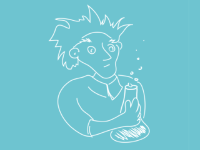Quick, Draw a Scientist!
As long as science is perceived as geeky, U.S. students are less likely to embrace STEM subjects. They need to reimagine what scientists look like.
In 1957, two anthropologists did a nationwide study to examine how 35,000 high school students from a range of backgrounds viewed a scientist. In this study, students were asked to draw a scientist -- and the most popular image drawn was a study in white. Scientists were characterized as white men with glasses and white hair and white beards, wearing white lab coats. Although this research took place nearly 60 years ago, some might say that little has changed.
Several more recent studies have shown that the same image of a scientist persists over a range of socioeconomic, racial, and gender backgrounds. It was found to exist across school grades, was firmly rooted in public and private schools, and had spread to different countries (Australia, Greece, and surprisingly China). We are in the midst of a science stereotype pandemic.
With such fixed and pervasive thinking, it seems like little can be done to overcome it. But fear not. A visit from a scientist with a diverse background can significantly alter how children view scientists.
Inoculating the Scientist Perception
While there are many studies documenting how children perceive scientists, some show how to change these impressions. One of these studies (PDF, 720KB) shows that meeting one scientist changes how all scientists are viewed. In this work, children were asked to draw a scientist, then a woman scientist visited the class, and then children were asked to draw another image after the visit. In the second set of images, the scientist drawn did not look like the first stereotypical one.
Several years ago, I read this study and decided to introduce scientists of different backgrounds to children when I created my science outreach program. As an engineering professor, I had a science show for kids, called Science Saturdays, which had the mission of making science fun and was based on the 3Ds: donuts, demonstrations, and dynamic talks. After reading that article, I added another D for diversity and invited a mix of scientists of different demographics (of age, gender, and racial backgrounds) to help us combat the perception of who does science.
Inoculating the perception of a scientist is tantamount to fixing the leaky STEM pipeline. If students don't think that being a scientist is for them, humanity loses. A diverse workforce is a better, faster, and stronger workforce. Scientists of diverse backgrounds working together are better suited to solve complex problems, can work with greater agility, and can cure diseases that have been overlooked. Einstein once said, "We cannot solve our problems with the same thinking we used when we created them." Given the world problems that we're facing -- like energy, pollution, and climate change -- we cannot overcome these crises using the same homogenous mindset and tools that got us here.
So here is how you can help change the world for the better and change the notion of a scientist -- have a scientist of a diverse background visit your school. If you're unable to do so, consider showing your students a clip of a movie with a scientist that is different from the stereotype. Movies like Contact, Outbreak, Thor, Twister, Jurassic Park, The Amazing Spider Man, Star Trek and others might help. And television shows like Bones, MythBusters, and Cosmos, as well as blogs on the role of black scientists and inventors, will show scientists of different genders and racial backgrounds, too.
Explore whether this activity has impact on your class. Have your students draw a picture of a scientist, do the above activity, and then have them draw another picture afterward. Encourage them to describe what a scientist should look like and why. Discuss the difference. The only way to overcome stereotypes is to expose them. Once students see that these stereotypes are false, they may start to think that science is not just for a few.
Making a Big Bang
To overcome scientist stereotypes, we need to do a better job at redefining geek and making nerdom more inclusive. Nerds are popular these days, as evidenced by the show The Big Bang Theory. Personally, this show makes me both happy and sad. The number of under-represented groups on this show is abysmal. (For the record, an Indian immigrant is not an under-represented person in the sciences; yes, Mayim Bialik is a scientist in real life and plays one on TV, too; and a Neil Tyson cameo is a good step, but not enough). Shows like this point to the general invisibility of women and people of color in the sciences.
In the U.S., we show geeks as caricatures of real people. But our world problems are way too important to continue doing that. There are people who like science but don't want to be geeks because geeks are the opposite of cool. A way to battle this is to have cool scientists on television. We need better science role models to give children a North Star for what is possible.
Thomas Kuhn, an MIT professor who studied the business of science, said that scientific revolutions occur in paradigm shifts. Science changes with radical events or discoveries and not by small increments. Promoting a cool scientist role model that makes science attractive to all children is a paradigm-shifting event. It would inoculate the stereotype of who does science, encourage a range of backgrounds into STEM, and better prepare us to solve the complex problems that surround us. Why wouldn't we want to do this? Our future selves will only ask why did it take so long.
